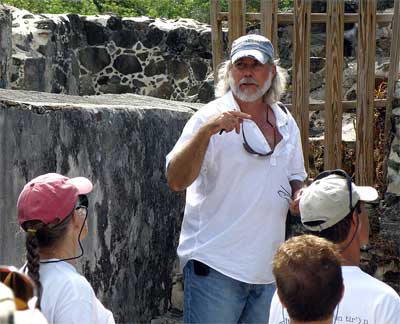Historical Society Installs Plant Signs at Annaberg and Provides Guidance to Friends‘ Docents
identifiying the plants and trees.
On Saturday, January 24th, St. John Historical Society President Eleanor Gibney and historian and Society Archivist David Knight met with the Friends of Virgin Island National Park Docents at the Estate Annaberg sugar works.
The Friends Annaberg Docent program began six years ago as an effort to provide a clear interpretation of the history of this estate to the visiting public. It is currently staffed by 12 dedicated volunteers, most of whom have been serving in this capacity for 3–6 years. Docents are on–site from 10 AM till 2:00 PM Monday through Friday, in the busy season, to provide an interpretation of the site and answer visitors’ questions.
Since the beginning, the docents have relied heavily on the research undertaken by David Knight on behalf of the Virgin Islands National Park (VINP.) His work is contained in an extensive report titled, “Annaberg: An Updated Survey of the Annaberg Factory Complex… With Overviews of Contributing Sites Within The Annaberg Historical District”, and is also captured in a booklet–sized summary of this volume entitled “Understanding Annaberg”—copies of which David provides on a complementary basis to both The Friends, for sale in their store, and to each docent.
On Saturday, Eleanor Gibney had been invited to speak to the group about the trees on the estate and the variety of the plants in the site’s demonstration garden, also known as the ‘provision grounds.’ She provided the Docents with an overview of the vegetation on the estate and then led a tour, identifying the plants along the way.
Last winter the St. John Historical Society proposed placing identification signs on the plants and trees on the estate to further enhance the educational experience of those visiting Annaberg. The Superintendent of the Virgin Islands National Park warmly embraced this idea and Eleanor subsequently made an inventory of those plants and trees which were present and typically found in the provision grounds of St. John estates in an earlier era. Last spring, the Society ordered some 27 signs and recently installed them on the grounds and in the garden.
David Knight had been invited to once again provide his perspective on the long and rich history of this estate, telling us that it was first settled in 1721 by the French Hugenot Issac Constantin, then passed through several more owners and eventually acquired by a wealthy merchant and slave trader of Irish descent, James Murphy, who was responsible for developing most of the estate as we see it today.

David Knight speaking to docents
Saturday’s get–together at Annaberg was a wonderful example of what can be accomplished when multiple unique organizations of St. John work together for a greater good… And clearly the public is well served by such efforts. If you haven’t been to Annaberg lately, it is certainly worth the visit… particularly during the time when the Friends’ Docents are there to provide an understanding of its history.
While at Annaberg, you may also wish to take a detour over to the historic Annaberg School site—which has recently been re–cleared by the Park Service and is the beneficiary of a new interpretive sign, thanks to the Historical Society.

